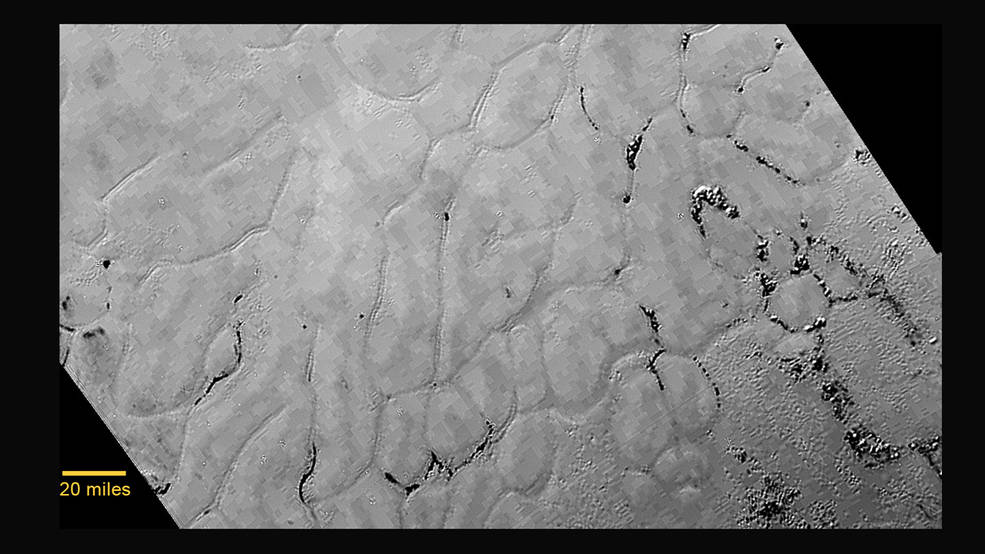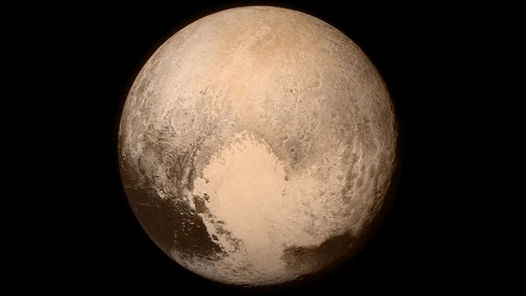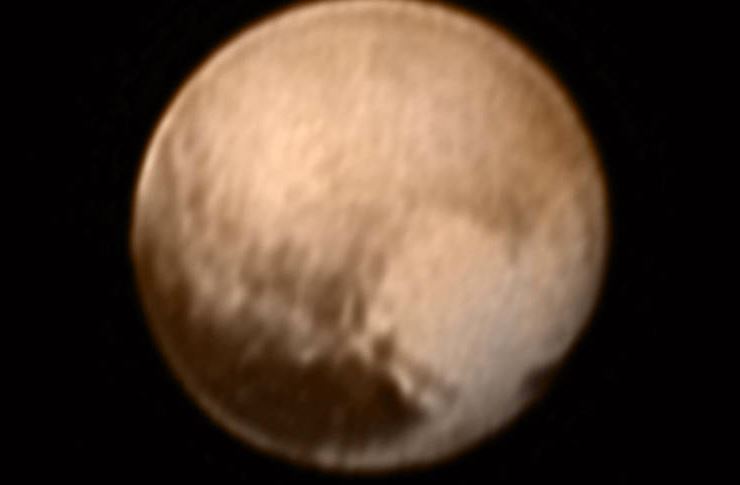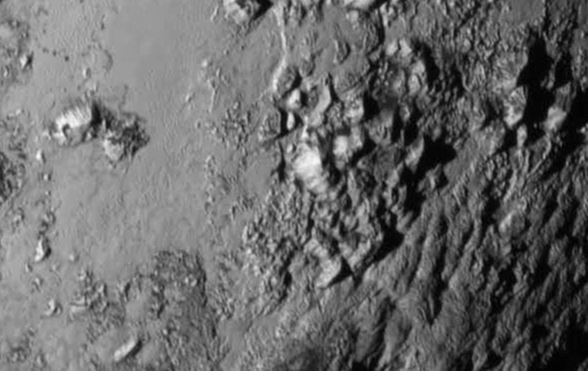Approaching the Sputnik plain without craters Pluto. Acquired on July 14 from Horizont ship New NASA at a distance of 77,000 kilometers. (NASA / JHUAPL / SwRI)
Astronomers studying the images taken by the spacecraft New Horizont during its closest approach to Pluto on July 14 revealed an area nicknamed “plain Sputnik “without craters, which must not have more than 100 million years of formation, and possibly still being shaped by geological processes.
The NASA stated on July 17 that this happens in the middle of the left side of the bright region of Pluto known as the “Heart”, also called “Tombaugh Regio” north of the ice mountains 3,500 meters high shown in previous days by astronomers.
“This frozen region is north of the mountains icy Pluto and has been named informally Planum Sputnik (Sputnik Plain), the first artificial Earth satellite. The surface appears to be divided into segments of irregular shape that are surrounded by narrow channels “, informed NASA.
Also observe something that seems to be groups of mounds and small wells, he said.

Sputnik Plain, an area without craters in the” heart “of Pluto, taken July 14 from Horizont ship New NASA at a distance of 77,000 kilometers. (NASA / JHUAPL / SwRI)
The photo, which surprises with details about a kilometer, was achieved with an imaging system long range on July 14 at a distance of 77,000 kilometers ( 48,000 miles).
The name “Tombaugh Regio”, the Heart, astronomers wanted to remind Clyde Tombaugh, who discovered Pluto in 1930.

Picture of Pluto it took the New Horizons probe on June 13 de 2015-476000 kilometers from its surface. (NASA / APL / SwRI)
Jeff Moore, geology team leader of New Horizons and the Ames Research Center of NASA in California, explained that “the discovery of vast plains without very young craters on Pluto exceeds all expectations “and even added,” is not easy to explain. “
This geological age Pluto estimated at 100 million years, in contrast to the age of the Earth and the Solar System that has a source of more than 4 billion years, according to previous records.
The NASA described the ice plain has a separate segment surface irregularly, about 20 kilometers (12 miles) wide, bordered by what appear to be shallow channels.
“Some of these channels have darker material within them, while others are drawn by groups of hills that seem to rise above the surrounding terrain. Moreover, the surface seems to be impregnated with small holes that may have formed through a process called sublimation, where ice changes directly from solid to gas, such as dry ice does on Earth, “described geologists .
It is recalled that NASA said it has observed methane ice on the surface of Pluto.
One of the theories put forward by scientists, it is that these irregular shapes “can be the result of the contraction of surface materials in a similar way to what happens when the mud dries. “
As an alternative theory, geologists propose that” may be a product of convection, waxy standing up on a lamp “.
” In Pluto, convection occur within a surface layer of frozen carbon monoxide, methane and nitrogen, driven by the low heat inside Pluto “he suggested the research team.
The darker stripes that are more than a kilometer long (a few miles), aligned in the same direction, it is believed that” may have been produced by the winds blowing through the frozen surface. “
NASA announced many more images of Pluto, and higher resolution, as digital recorders spacecraft sent back to Earth all Data over the next year.
The New Horizons team specializing in the study of the atmosphere on Pluto noted that the atmosphere reaches 1,600 kilometers (1000 miles) above the surface, rich in nitrogen.
“This is the first observation of Pluto’s atmosphere at altitudes above 270 kilometers (170 miles) above the surface,” NASA said.
The team studying the tiniest particles and as the solar plasma composed of ionized particles released during the continuous eruptions of our star, also highlighted new features of the ninth planet.
They announced the discovery of a cold region with a dense ionized gas thousands of kilometers beyond Pluto. This means, according to scientists, that “the planet’s atmosphere is being stripped by the solar wind and is lost into space,” they stressed the scientists.

Fotografíia Pluto taken from the New Horizons spacecraft NASA’s July 7, 2015 . To the right is observed luminous heart, and izquerda the body and head of dark whale. (NASA)
“This is just a first plasma environment tempting to look Pluto,” said Fran Bagenal of the University of Colorado, Boulder, co-investigator of New Horizont.

Mountains over 3000 meters in height revealed on the surface of Pluto on July 14, 2015 in the area known as the “Heart”
Jim Green, director of NASA’s Planetary Science, the exhibition of “plain Sputmik” recalled that “the ten-year journey to Pluto has finished -but The fruits of reward for science are just beginning. “
The New Horizont ship, built by the Applied Physics Laboratory of Johns Hopkins University in Laurel, Maryland, left Earth in 2006 , marking a record with his trip. While waiting for more data in the coming months, now is touring the area Kuiper Belt, characterized by orbiting the Sun have numerous rocky bodies like asteroids.
No comments:
Post a Comment